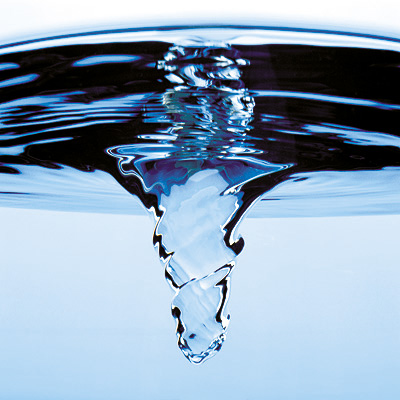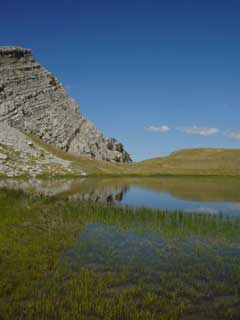Topics
- Regional water observation mechanism
- Regional Cooperation Assessment
- Water Quality Monitoring (JP)
- Water scarcity and drought (JP)
- Groundwater (JP)
- Waste water reuse (JP)
- Shared Water Resources Management (JP)
- Linking rural development and water management (JP)
- Waste management
- Water institutions
- Climate Change
- Floods
- Desalination
- Right to Water
- Irrigation
- Satellite data
- Water reports & data
- Hydrology
- Sanitation
- Gender and IWRM
- ArabWAYS
- Non-Revenue Water
- Virtual Water & Water Footprint
- WANA Water Panel
- Water Demand
- Water Governance
- Water Pricing
- Water accounts
- Water nexus Energy
- Geosciences
- Rural Management
 Basics of evapotranspiration
Basics of evapotranspiration
Courtesy of Stevens Water Monitoring Systems, Inc.
Originally published Aug. 2008
Evapotranspiration
(ET) represents the loss of water from the Earth’s surface from the
combination of direct evaporation and plant transpiration. ET is
usually expressed as a rate such as inches per day. Knowledge of ET is
important for irrigation scheduling but it is also an important factor
for other land use applications such as septic tank drain fields, water
shed water budgeting, and climate and weather models. ET can be used as
a historical tool but usually it is predicted or used in a forecast to
help irrigators optimize irrigation.
| Released | 02/09/2008 |
|---|
Factors Affecting ET
Current weather conditions and soil conditions are the primary factors affecting ET rates. The weather factors include wind speed, air temperature, relative humidity, and sun light. The affect weather has on ET rate is rather intuitive. Warm, sunny, and dry weather with a lot of wind will have greater ET rates. The ET rates between different plant species can vary greatly. For example, needle leaf trees such as pine trees will have a much greater ET than a deciduous tree such as an oak tree. Even though the pine needle can be very small, the needles have much more surface area than deciduous leaves allowing for more transpiration.
Soil chemistry is also a major factor affecting ET rates. At the molecular level, most clays will have a chemical affinity for water. Clay’s chemical affinity for water results from a planner geometry and the charge distribution at the molecular level. The chemical affinity for water is much less for sands and silts. The chemical interaction between the clay and the water impedes both the evaporation and the plant transpiration. The evaporation rate of a soil the is mostly sand on the other hand, will be close to what the evaporation rate would be out of a pan.
For example, if the soil moisture is 20% by volume, the ET rate in sand would be very high and very low in clay under the same weather conditions. On the other hand, if the soil moisture is 30% by volume, the sandy soil will dry out quicker than the clay rich soil and the clay rich soil will have a higher ET rate for a longer period of time.
Soil salinity will affect the plant transpiration. Plant transpiration is the movement of water from the roots and the subsequent loss of water vapor from the stomata in the leaves. The primary driving force of the movement of water from the roots to the leaves is osmoses. Osmoses is the diffusion or movement of water that is driven by a salt concentration gradient. Increasing soil salinity will decrease plant transpiration because the salt concentration gradient will diminish thus affecting the over all ET. In general ET rates increase toward the equator and will be higher in summer than in winter.
In areas where ET is greater than precipitation, there will be very little recharge to the aquifer and a net upward movement of water. This net upward movement of water followed by ET will cause salts and minerals to accumulate near the surface. This explains why soils in arid lands tend to have a high pH and a higher salinity.
Other factors that affect ET include elevation, longitude, latitude and time of year. Conversely, if precipitation is greater than ET, minerals and nutrients will be leached out of the soil, and there will be a shallow aquifer. Highly leached soils will develop more clay loam textured soils and will typically have a lower base saturation.
Current weather conditions and soil conditions are the primary factors affecting ET rates. The weather factors include wind speed, air temperature, relative humidity, and sun light. The affect weather has on ET rate is rather intuitive. Warm, sunny, and dry weather with a lot of wind will have greater ET rates. The ET rates between different plant species can vary greatly. For example, needle leaf trees such as pine trees will have a much greater ET than a deciduous tree such as an oak tree. Even though the pine needle can be very small, the needles have much more surface area than deciduous leaves allowing for more transpiration.
Soil chemistry is also a major factor affecting ET rates. At the molecular level, most clays will have a chemical affinity for water. Clay’s chemical affinity for water results from a planner geometry and the charge distribution at the molecular level. The chemical affinity for water is much less for sands and silts. The chemical interaction between the clay and the water impedes both the evaporation and the plant transpiration. The evaporation rate of a soil the is mostly sand on the other hand, will be close to what the evaporation rate would be out of a pan.
For example, if the soil moisture is 20% by volume, the ET rate in sand would be very high and very low in clay under the same weather conditions. On the other hand, if the soil moisture is 30% by volume, the sandy soil will dry out quicker than the clay rich soil and the clay rich soil will have a higher ET rate for a longer period of time.
Soil salinity will affect the plant transpiration. Plant transpiration is the movement of water from the roots and the subsequent loss of water vapor from the stomata in the leaves. The primary driving force of the movement of water from the roots to the leaves is osmoses. Osmoses is the diffusion or movement of water that is driven by a salt concentration gradient. Increasing soil salinity will decrease plant transpiration because the salt concentration gradient will diminish thus affecting the over all ET. In general ET rates increase toward the equator and will be higher in summer than in winter.
In areas where ET is greater than precipitation, there will be very little recharge to the aquifer and a net upward movement of water. This net upward movement of water followed by ET will cause salts and minerals to accumulate near the surface. This explains why soils in arid lands tend to have a high pH and a higher salinity.
Other factors that affect ET include elevation, longitude, latitude and time of year. Conversely, if precipitation is greater than ET, minerals and nutrients will be leached out of the soil, and there will be a shallow aquifer. Highly leached soils will develop more clay loam textured soils and will typically have a lower base saturation.
Source: http://www.environmental-expert.com
Login to add a comment
 you are not logged in
you are not logged in






